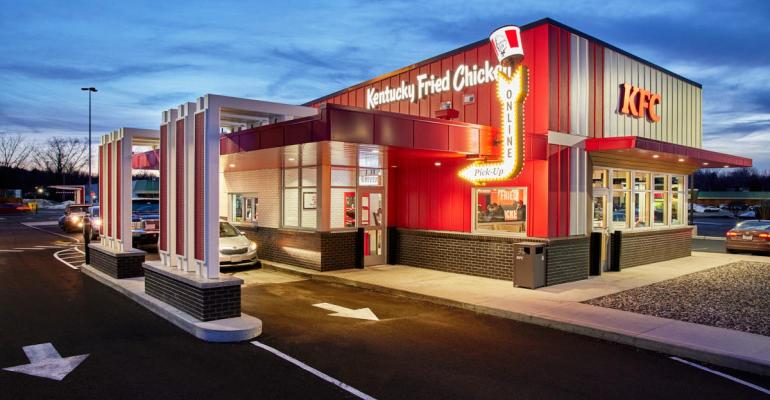Throughout the past several quarters, Taco Bell has hogged the spotlight for Yum Brands’ earnings results. That spotlight in Q2, however, belonged to KFC.
Yum today reported a 9% increase in same-store sales on the quarter – nearly 2% higher than analysts’ expectations. Global sales jumped 13%, with KFC up 19%, and both Taco Bell and Pizza Hut up 7%. Comp sales increased 13% at KFC, 4% at Taco Bell, and 4% at Pizza Hut. Habit Burger Grill, the newest and smallest chain in the company’s portfolio, increased system sales by 9% with flat same-store sales.
Much of KFC’s performance came from a recovering China business, though the U.S. market was up 5% driven by “a combination of product innovation and always-on value strategy,” CEO David Gibbs said during the earnings call Wednesday morning. KFC’s nuggets launch in late March generated transaction growth, with 100 million sold in the first eight weeks. Gibbs said the product also appealed to younger and new customers and built upon an already established sales layer from the chain’s sandwich launch in 2021.
Taco Bell’s Taco Tuesday campaign, featuring Lebron James, created “massive brand buzz, engagement and mentions” that surpassed such metrics from the Mexican pizza relaunch last year, Gibbs said. The chain also continues to drive transactions through its consumer value proposition, such as the build-your-own Cravings Box, while maintaining over 25% margins. Notably, Taco Bell is experiencing growth in both the breakfast and late-night dayparts, signaling a return to normalcy after the past three years.
Momentum from Pizza Hut’s Melts platform, launched at the end of last year, continued in Q2 and Gibbs said the chain is gaining share in the pizza category. The chain also continues to gain incremental customers through its third-party aggregator partnerships, introduced last year.
Meanwhile, the development machine kept churning for Yum during Q2, as well, with a total of 1,025 gross new units. Executives noted on the call that the company is expecting its full year results to “deliver well above its long-term algorithm.”
“Just in the last two and a half years, we’ve added 10,000 new gross units to the Yum system. That’s nearly 20% of our stores built in the last two and a half years,” Yum CEO David Gibbs said during the call Wednesday morning. “Think about our brands and their 60-plus years of operating history, but they couldn’t be more new and fresh to consumers and they couldn’t be performing any better. We’re getting results the right way – through digital growth, development and franchisees being profitable.”
About that digital growth – the company experienced nearly a 30% digital sales increase on the quarter. Digital sales now represent over 45% of global system sales, or about $7 billion, and generate incremental sales through higher spend and frequency, as well as incremental profitability, CFO Chris Turner said.
In the U.S., KFC leveraged Yum’s commerce platform to enable a Diablo IV marketing campaign, which offered customers exclusive in-game rewards in exchange for KFC purchases. Turner said by leveraging in-house technology, the campaign was activated within weeks, versus the previous process, which would have taken months and “significant” third party expenses.
Further, the Taco Bell system migrated all of its digital traffic onto the platform, while Pizza Hut U.S. will migrate throughout the rest of this year.
Yum’s recommended ordering system, an AI/machine learning module that predicts how much food a GM should order, was deployed to 800 stores in the second quarter, and is now live in over 4,400 KFC and Taco Bell U.S. stores. And, Yum’s next gen point-of-sale system, which Turner said improves operational efficiencies and enhances team member effectiveness, was deployed to 1,000 Taco Bells in the quarter, with a 5,000-unit target by the end of the year.
“These are the latest steps to one day achieve 100% sales powered by digital,” Turner said. “We’re excited about the progress we’re making on all aspects of our digital strategy. The benefits we derive when we platform systems like this, we think it drives faster, profitable growth for franchisees and for us.”
Yum by the numbers:
- KFC system sales up 19%; same-store sales up 13%
- Taco Bell system sales up 7%; same-store sales up 4%
- Pizza Hut system sales up 7%; same-store sales up 4%
- KFC U.S. Q2 sales up 5%
- Taco Bell same-store sales up 4%
- Pizza Hut U.S. sales up 2%
- Habit Burger Grill system sales up 9%; same-store sales flat
Contact Alicia Kelso at [email protected]

